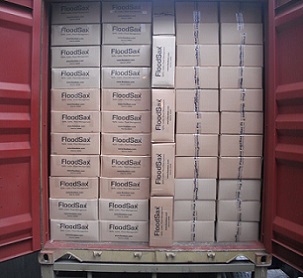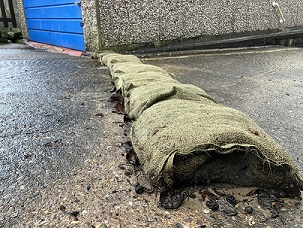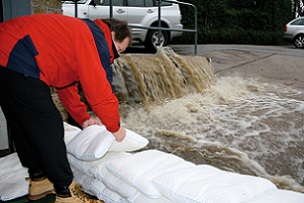 Boxes of FloodSax packed into a lorry. Each FloodSax contains 20 FloodSax and there are 30,000 FloodSax on this one vehicle.
Boxes of FloodSax packed into a lorry. Each FloodSax contains 20 FloodSax and there are 30,000 FloodSax on this one vehicle.
 Sandbags often deteriorate and fall apart once they come into contact with water
Sandbags often deteriorate and fall apart once they come into contact with water
 FloodSax alternative sandbags keep their shape and can hold back a torrent of floodwater
FloodSax alternative sandbags keep their shape and can hold back a torrent of floodwater
So how do you fit 30,000 ‘sandbags’ onto one lorry?
Transporting sandbags is a costly business as they weigh so much and take up loads of space on lorries and in warehouses.
There is an easier and cheaper way where 30,000 FloodSax ‘sandless sandbags’ can fit onto a 40ft-high container and the weight won’t be a problem at all.
While you’ll only get 50 or 60 traditional sandbags on a pallet, you’ll get 24 boxes of FloodSax on one and with 20 FloodSax in each box that’s 480 FloodSax on just one pallet. A lorry can take 1,500 boxes of FloodSax making 30,000 in all, massively saving on transport and storage costs.
This ease of transport is because FloodSax alternative sandbags are transformed into highly effective anti-flood barriers when they are immersed in water.
A special gelling polymer inside the bag absorbs up to 20 litres of water and retains it so the FloodSax grows in size to be larger and more uniform in shape than old-style sandbags, making them far better to be built into protective barriers to prevent flooding.
But the beauty of the Floodsax over the sandbag is that they are multi-purpose and ultra-flexible so, in their dry state, can be used inside homes, businesses and public buildings such as hospitals to soak up spills, leaks and floods, often in hard-to-reach places such as underneath sinks, beneath boilers and even below floorboards.
FloodSax are also way more environmentally friendly than sandbags as they are largely biodegradable so can be disposed of in landfill.
And, despite all this, they’re usually cheaper too.
Prefilled sandbags can cost upwards of £165 for 20 including delivery while the retail cost of 20 FloodSax is £140 and less than that for trade customers.
FloodSax are made by award-winning pioneering company Environmental Defence Systems based in Huddersfield, West Yorkshire.
Lucy Bailey from EDS said: “Many councils are now completely stopping using any sandbags as they realise they are ineffective at stopping floods, deteriorate quickly when they come into contact with water and the sand gets washed down the drains and clogs them up.
“FloodSax are so much more cost-effective, flexible and greener.”
FloodSax are vacuum-packed in packs of five making them incredibly space-saving to store unlike sandbags that need vast warehouse space and, if they get damp, they can quickly start to fall apart.
For more on FloodSax go to https://www.floodsax.co.uk/, email info@edslimited.co.uk or call on 0485 641009.